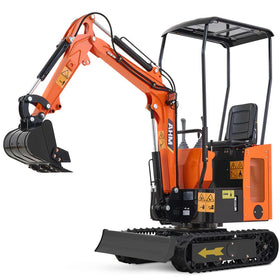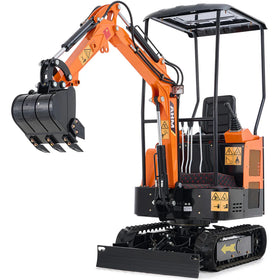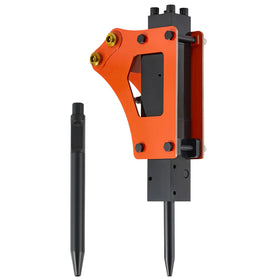So, you have just finished a large construction project, and now you need to clean up the construction site from all the debris and trash. Obviously, doing it manually would take too much time and effort, and there are tools and machines that could do it instead.
For example, did you know you could attach hydraulic root grapple on a skid steer loader and collect the debris quickly and efficiently? Yes, this attachment is perfect for such tasks, but you will need to install it. Keep reading this article to learn more about the installation process:

What Can You Do With a Hydraulic Root Grapple
First, before you learn how to attach hydraulic root grapple on a skid steer loader, let’s see where you can use it. This skid steer loader attachment is particularly useful for handling heavy materials and objects. It has strong, curved tines that can grab various objects and materials. Some of the tasks performed with a hydraulic root grapple are the following:
- Moving logs
- Clearing bushes and trees
- Digging our stumps and roots
- Transporting rocks and boulders
- Clearing various debris
- Grading and leveling the ground

5 Steps To Attach Hydraulic Root Grapple On Skid Steer Loader
Now, let’s see how you can attach hydraulic root grapple on skid steer loader in 5 easy steps:
Step 1: Prepare Your Tools and Equipment
To start, you should gather all of the tools and equipment that you might need. That includes wrenches, safety goggles, and safety gloves. If your skid steer loader doesn’t have its own hydraulic hoses and couplers, and if they weren’t included when you bought the root grapple attachment, you will need to get them as well.

Step 2: Position Your Skid Steer Loader and the Root Grapple
Once you have collected everything you will need, it is time to park your skid steer loader somewhere with an even and stable terrain. Lower the loader’s arm and turn off the engine. Bring the root grapple close to the skid steer loader and position it so that they align. The loader’s arm should be perfectly aligned to the root grapple’s attachment points.
Step 3: Connect The Attachment To The Skid Steer Loader
There should be grapple pins that you can insert into the corresponding holes of the loader’s arm. Make sure that the pins are in place and securely inside the designated holes. Then, it’s time to connect the hydraulics.
Take the loader’s hydraulic hoses and connect them to the grapple’s port or hose connectors. Make sure these attachments are firm and secure. Also, this is a good time to check the hydraulic hoses and see if there are any leaks. Tie or fasten the hydraulic hoses so that they don’t get in the way of other moving parts.
Step 4: Test The Grapple
Go to the control area of your skid steer loader and start the engine. Move the loader’s arm up and down and tilt it backward and forwards. This will help you see if the grapple is properly attached and if it works as it should. If you notice anything wrong, turn off the loader’s engine and recheck the connection between the grapple and your skid steer loader. If needed, detach and then attach hydraulic root grapple on skid steer loader for the second time. Maybe you missed something the first time, and this time, you will get it right.
Step 5: Final Safety Checks
Finally, once you have ensured that the root grapple is attached to your skid steer loader and working properly, it is time to do some final safety checks. Take another look at the hydraulic hoses, as they can be prone to damage and leaks. Then, check the moving grapple parts, as well as the loader’s arm. If you see any major signs of wear and tear, you shouldn’t be using your skid steer loader until you fix the issue. Check the rest of the machine just to make sure there are no hidden issues and safety hazards.

How To Buy a Hydraulic Root Grapple
If you still need to buy a hydraulic root grapple, we have a few tips for you. First of all, you should ensure that this attachment is compatible with your skid steer loader. The best way to do it is to buy it at the same place where you bought your loader, but you can also simply do some research and find a compatible root grapple in another place.
You should also buy root grapple attachments from reputable sellers only. This ensures the quality of the root grapple, as well as the warranty and support you will receive in case of any issues or questions that you might have. With that being said, let’s take a look at some good options:
23HP Mini Skid Steer B&S Engine with Bucket
For those who still need to buy the skid steer loader, this machine could be a perfect choice. It supports many different attachments, including the root grapple, skid steer loader material bucket attachment, and many more. It has an easy-to-use attachment mounting system that will allow you to change the attachments effortlessly.

38" Hydraulic Root Grapple Attachment For Mini Skid Steer Loader
If you need an efficient and high-quality root grapple attachment, look no further than this one. It is compatible with many skid steer loaders, including the one that we mentioned above. Made of durable steel, this root grapple will be able to withstand even the most demanding tasks.
Conclusion
In this article, we have shown you how to attach hydraulic root grapple on skid steer loader. However, we also tried to give you some tips and teach you even more about this versatile and practical attachment type. Once you learn how to install and use it, there will be barely any tasks that you won’t be able to do with your skid steer loader!







